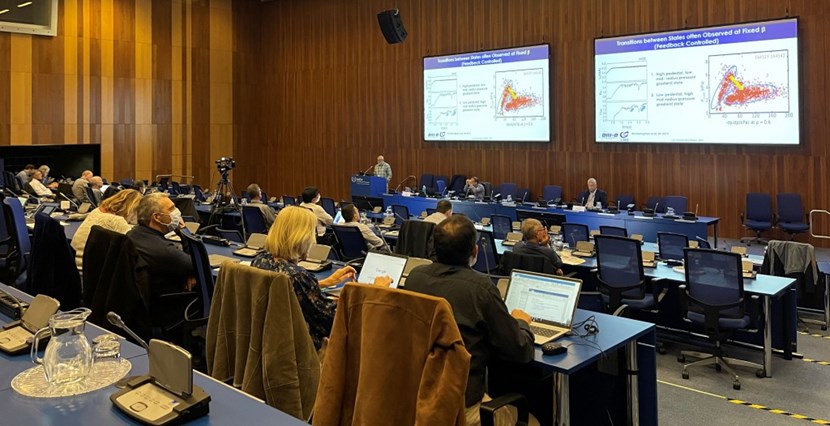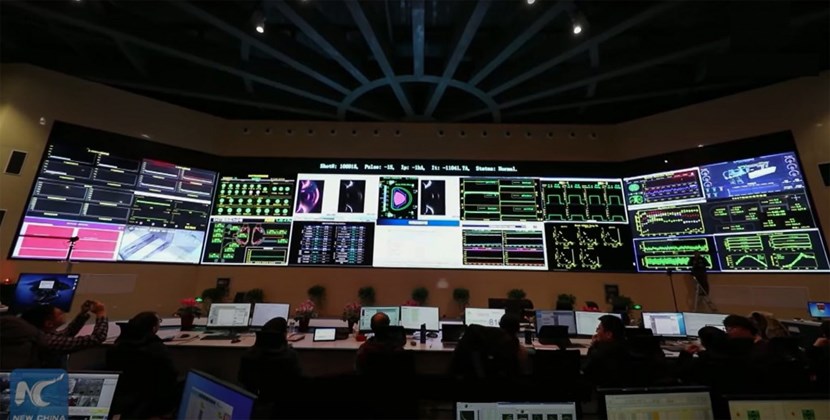ITER NEWSLINE
-
Fusion world
Mobilizing for long-pulse operation
Xavier Litaudon, CEA, and Sun Hee Kim, ITER Organization
Fusion world | Mobilizing for long-pulse operation
One of the key operational challenges in the development of fusion energy is the achievement, simultaneously, of high fusion performance and long-pulse operation. This is one of ITER's key missions, and an essential milestone on the road to a fusion power plant that delivers a stable electricity load to the network. In this context, a Technical Meeting on Long-Pulse Operation of Fusion Devices was held at the International Atomic Energy Agency's (IAEA) Headquarters in Vienna, Austria, from 14 to 16 November 2022, to review, discuss and address scientific and engineering issues related to steady-state and long-pulse operation of fusion devices.

The first IAEA Technical Meeting on Long-Pulse Operation of Fusion Devices was held in Vienna, Austria, from 14 to 16 November. Controlling fusion plasma for long periods, while gaining experience in steady-state and/or long-pulse operation with active cooling systems, is essential for the success of ITER and demonstration fusion power plants.
A measure of fusion plasma performance is power amplification (Q), defined as the ratio of the fusion power produced to the additional heating externally applied to maintain a steady-state. On ITER, high-Q operation will be sustained for a duration of the order of 300-500s (Q=10 milestone) and up to 3000s for Q ≥ 5 operation aiming at steady-state. The ITER Research Plan describes the strategy to achieve these goals. Success relies on solving challenges in an integrated manner addressing both operational and scientific issues (e.g., how to set-up long-pulse operational regimes) and engineering issues (e.g., how all components are actively water-cooled).
Controlling fusion plasma for long periods, while gaining experience in steady-state and/or long-pulse operation with active cooling systems that can maintain the plasma-facing components at a stable temperature, is essential for the success of ITER and demonstration fusion power plants. To facilitate the coordination on these challenges, the International Energy Agency (IEA), with IAEA support, established a network in 2020 for Coordination on International Challenges on Long duration Operation, or CICLOP (the wink to Greek mythology might not be accidental, as the Cyclopes were reputed to be supernaturally skilled craftsmen!). The objectives of the CICLOP group are to promote activities, and collect and disseminate information on the physics and engineering issues of long-pulse operation for tokamak and stellarator facilities by sharing best practice, operational procedures, experimental data and simulation programs, and by coordinating experiments between the fusion-related IEA Technology Collaboration Programmes in close cooperation with the IAEA activities in the same field through a series of technical meetings on long-pulse operation of fusion devices.
The group is presently chaired by Xavier Litaudon (CEA, France) and co-chaired by Hans-Stephan Bosch (Max-Planck-Institut für Plasmaphysik, Germany) and Tomohiro Morisaki (National Institute for Fusion Science, Japan), with Matteo Barbarino from the IAEA as scientific secretary. As a common activity, the group has already set up a high-level, multi-machine database to address physics and engineering long-pulse operation issues for tokamaks and stellarators.
The first Technical Meeting on Long-Pulse Operation of Fusion Devices¹ hosted at the IAEA welcomed more than 50 experts in the field (including up to 10 who were connected remotely) from the ITER Organization, Europe, China, the United States, Korea and Japan—all specialists committed to taking up the challenge of addressing the scientific and engineering issues related to the long-pulse operation of fusion devices. The event brought together junior and senior fusion scientists, plasma physicists (theoreticians, modellers and experimentalists) and engineers in order to cover a broad array of physics and engineering issues. The technical and discussion sessions have focused on the following topics: (i) Long-pulse operation performance and control, (ii) Plasma-wall interactions, exhaust and control, (iii) Heating and current drive and RAMI (Reliability Availability Maintainability Inspectability) aspects for long-pulse operation.
The scientific program of the meeting was set up by the CICLOP group. The chairs of the various sessions were selected from the CICLOP group members who provided, in the concluding session on Wednesday 16 November, a high-level summary of the actions and the major issues raised during the meeting that were discussed. All presentations are available from the IAEA website at this address.

The Chinese tokamak EAST, whose control room is pictured here, is one of the tokamaks around the world that have achieved progress in support of ITER's planned long-pulse operation.
In particular, the focus of the discussion was on the present physics and technology limits in fusion performance and duration and how to collectively support long-pulse operation development on ITER and beyond. In the first invited lecture at the start of the meeting Sun-Hee KIM, from the ITER Organization, presented ITER long-pulse and steady-state operation candidate scenarios and possible paths to be explored during the ITER Pre-Fusion Power Operation (PFPO) Phase as part of the ITER Research Plan. The ITER Research Plan foresees the exploration of long-pulse operation already starting from the PFPO phase to develop, as far as possible, the scenario and control schemes required but also to make strategic decisions on upgrades of auxiliary heating and current drive systems and other ancillary systems that may be needed prior to long-pulse operation in the Fusion Power Operation (FPO) phase. Identification of operational paths supporting the extrapolation from non-active phases to deuterium-tritium long-pulse and steady-state operations in the FPO phase would be one of the main research activities during the PFPO phase. Much progress in support of this ITER goal was reported from superconducting and actively cooled facilities around the world during the meeting:
- EAST (China) has reported a world record in pulse duration in tokamaks (1056s with 1.73 gigajoules of injected energy) following major upgrades;
- KSTAR (Korea) and EAST (China) have reported long pulses in H-modes with a record duration of 310s on EAST;
- WEST (France) has installed an actively cooled divertor with ITER plasma-facing-units; commissioning started in 2021 and full operation is planned in 2023;
- Similarly, Wendelstein 7-X (Germany) has installed an actively cooled divertor (2021); commissioning started in 2022 and full operation is planned in 2023;
- LHD (Japan) has reported on deuterium long-pulse operation and advanced control algorithms to avoid radiative collapses, together with long-pulse operation (2859s) where up to 3.36 gigajoules of energy has been injected.
Future plans for long-pulse operation on JT-60SA (Japan) were also presented to demonstrate real-time control capabilities. In addition, experts from ASDEX Upgrade (Germany), DIII-D (USA), QUEST (Japan, Kyushu University), TCV (Switzerland) and the European device JET (United Kingdom) reported efforts on operational scenario development that could be extrapolated (through simulation) to long durations if the engineering limits of the machines could be overcome. Finally, United Kingdom Atomic Energy Authority and General Atomics (USA) experts presented their paths for the development of compact, economical fusion reactors based on advanced concepts, while experts from Oak Ridge National Laboratory (USA) stressed the engineering challenges.
To conclude, it was agreed to have a similar event in 2024 to report on the major progress expected in the coming two years in this challenging and active field of research.
¹ The meeting is an extension of the previous IAEA Technical Meeting on Steady State Operation.
return to the latest published articles



